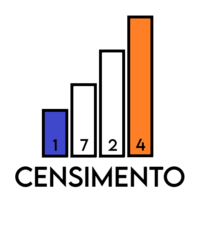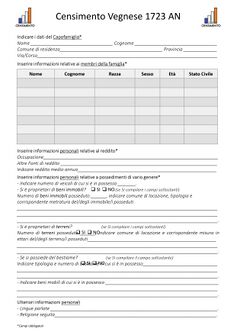1724 Vegnese Census: Difference between revisions
OlegnalehciM (talk | contribs) |
OlegnalehciM (talk | contribs) No edit summary |
||
| Line 160: | Line 160: | ||
|} | |} | ||
== See also == | |||
* [[Template:VEGcityPOP|Vegnese population division]] | |||
{{Vegnese Censuses}} | {{Vegnese Censuses}} | ||
[[Category:Vegno]] | [[Category:Vegno]] | ||
[[Category:Censuses]] | [[Category:Censuses]] | ||
[[Category:Censuses of Vegno]] | [[Category:Censuses of Vegno]] | ||
Revision as of 11:09, 27 September 2023
 Logo of the 1724 Vegnese census. | |
| Date | 15.III.1724 AN until 25.XI.1724 AN |
|---|---|
| Location |
|
| Budget | 50 million Rin |
| Organised by |
|
| Outcome | Census counts 5,648,807 inhabitants in Vegno. |
The 1724 Vegnese census was the first comprehensive census conducted by the Government of Vegno since its establishment in 1705 AN. Executed by the Ministry of the Interior, the census was programmed to officially establish the vegnese population, which had previously only been estimated on the basis of surveys and the population actually voting in the elections. Planned by the Greco I Cabinet, it secured an important civic participation, offering many different ways for residents to participate, including a secure online platform, in-person interviews, or traditional mail submission.
The real objective of the census was to register the entire population with certainty and also guarantee to those subjects, still residing in rural villages and in the hinterland, Vegnese citizenship and thus include them in civic society.
Background and Organization
Before the 1724 AN census, Vegno's population estimates were mainly based on unsystematically collected data, often concentrated in urban areas and with a significant underestimation of rural populations who, having even a low level of education, did not care nor to personally apply for citizenship, nor to vote in political elections. However, the growing importance of state administration and the need to collect taxes more equitably led the government to organize the first complete census of the population, also to allow all those citizens not yet registered to acquire citizenship and enjoy the services that the new Vegnese society offered compared to the previous period of nomadism without a central administration.
The 1724 AN census was a large-scale operation involving government officials, employees and volunteers across the country. The government issued a decree ordering all citizens of Vegno to actively participate in the census, providing accurate and complete information on their families and properties. Those who wanted and were able to do so could communicate their data and responses to the questionnaires via secure online platform, or traditional mail submission. For the rest of the population and especially for villages and rural aggregations, some government officials were responsible for coordinating the census in their respective districts and municipalities, while clerks recorded the information on specially designed forms. Volunteers from the various provinces also played a key role in reaching isolated rural communities and nomadic populations, ensuring more complete coverage.

Questions and Format
The 1724 AN census included a series of questions aimed at gathering demographic, economic, and social data. Some of the most common questions were:
- Name and surname of the head of the family.
- Age, gender and marital status of family members.
- Employment and sources of income.
- Land and real estate.
- Number of livestock and movable property.
- Religion and spoken language.
Participants were provided multiple ways to complete the census, including a traditional paper form compilated by the government officials head-to-head with the person and an online secure form, for those who wanted to send their data personally.
Results
The results were analyzed by the Ministry of the Interior with the help of the Artificial Intelligence provided by the company Sentient Solutions Inc.. The online system where the data were uploaded by government employees, once the various questionnaires had been filled out, allowed seamless data collection and real-time analysis across the various provinces within Vegno, saving a lot of time and money in analyzing the results.
The results of the 1724 AN census revealed a significantly larger population than previously estimated. The careful recording of rural and nomadic populations revealed a previously underestimated demographic dimension. This had important consequences for taxation, public administration and economic and social planning of the country.
Furthermore, the census contributed to a greater understanding of the linguistic, religious and economic diversity of Vegno, helping the government to develop policies more suited to the needs of the different communities.
At the end, the census counted a total of 5,648,807 inhabitants in Vegno.
By Region
| Region | Population | % of National Population |
# Change | % Regional
Change |
% National
Change |
|---|---|---|---|---|---|
| Badia | 183,587 | 3.25% | ▲68,902 | ▲60.08% | ▲1.22% |
| Bassovento | 190,382 | 3.37% | ▲87,389 | ▲84.86% | ▲1.55% |
| Buonriposo | 606,117 | 10.73% | ▲36,456 | ▲6.4% | ▲0.65% |
| Caponord | 310,685 | 5.5% | ▲183,608 | ▲144.49% | ▲3.25% |
| Compare | 251,937 | 4.46% | ▲107,535 | ▲74.47% | ▲1.9% |
| Falange | 606,117 | 10.73% | ▲177,957 | ▲41.56% | ▲3.15% |
| Falangetta | 22,031 | 0.39% | ▲9,885 | ▲81.39% | ▲0.17% |
| Falangina | 42,367 | 0.75% | ▲13,428 | ▲46.4% | ▲0.24% |
| Largoprato | 234,991 | 4016% | ▲141,300 | ▲150.82% | ▲2.5% |
| Mhazar-Campoasciutto | 668,254 | 11.83% | ▲27,166 | ▲4.24% | ▲0.48% |
| Pelago | 614,591 | 10.88% | ▲188,220 | ▲44.14% | ▲3.33% |
| Ponente | 685,201 | 12.13% | ▲204,300 | ▲42.48% | ▲3.62% |
| Region of Cossa | 1,000,969 | 17.71% | ▲229,458 | ▲29.74% | ▲4.06% |
| South Coast | 231,602 | 4.1% | ▲141,307 | ▲156.5% | ▲2.5% |
| TOTAL | 5,518,303 | 100% | |||
See also
| |||||